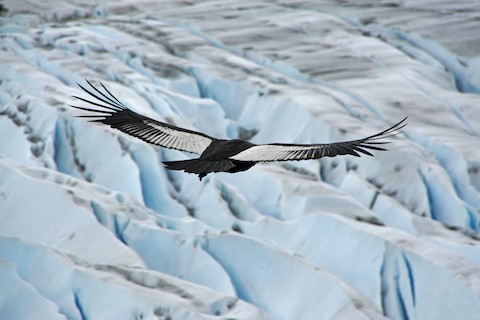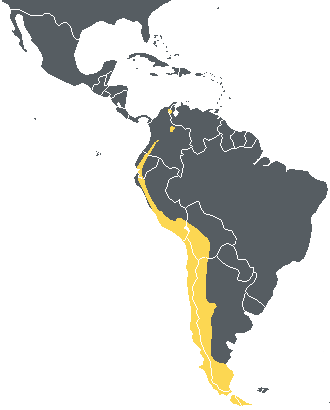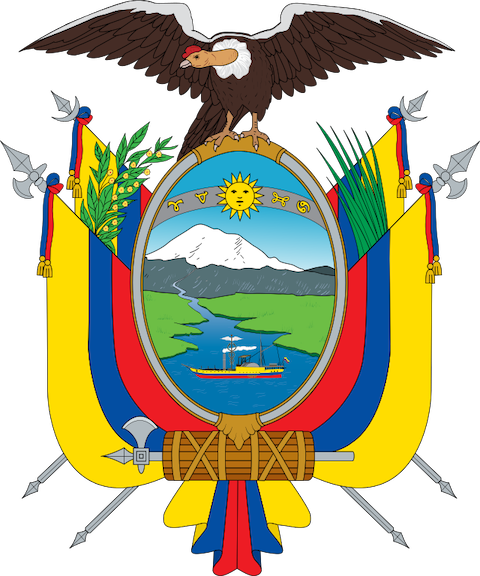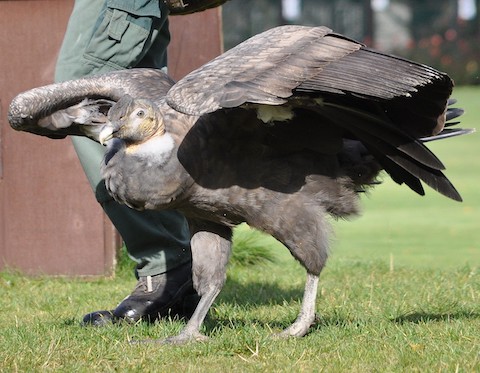
The Andean Condor is a giant vulture that lives along South America’s west coast. It’s one of the heaviest flying birds in the world, weighing more than 30 pounds. Yet it can stay aloft for hours at a time.
How do condors do it? Efficiency!
The condor launches itself from a high peak or cliff, spreads its massive wings—the largest in surface area of any living bird—and soars.
It will then ride thermals, currents of hot air rising from the ground, scanning the land below for carrion to scavenge.
If the condor doesn’t find a meal, it soars on, transitioning from one thermal to the next.
Scientists recently tracked one bird and found it could fly this way for five hours, covering more than a hundred miles, without flapping even once!
In fact, condors have been shown to flap their wings only one percent of their total flight time, with 75 percent of their energy expended just getting airborne.
Because takeoff is so energy intensive, the big birds must avoid unnecessary landings. Meaning they have to manage their flight path very carefully.
How can they navigate from one invisible rising air current to another? Perhaps they watch the behavior of other birds or have learned to read the landscape to look for terrain that could produce updrafts.
Scientists still don’t know; a mystery that perhaps one day we’ll be able to reveal on EarthDate.
Background
Synopsis: The Andean Condor is the largest soaring bird on Earth. Recently, scientists monitored one of these huge raptors soaring for five hours, covering a distance of 106 miles (172 km) without a single flap of its wings. Soaring birds conserve energy by using thermals and wind updrafts, just like glider pilots.
- Earth’s largest living scavenger is also its largest soaring bird—the Andean Condor (Vultur gryphus).
- Andean condors have a wingspan of more than 10 ft (3.2 m) and an average weight of 33 pounds (15 kg), making them about 20% larger than California condors.
- They are scavengers that feed mainly on the decaying flesh of large terrestrial and marine mammals.
- Andean condors may have the longest lifespan of living birds. One individual named Thaao was born in captivity in 1930 and lived until January 2010, reaching the age of 79 years.
- They live along the length of the Andes Mountains of South America and in the Santa Marta Mountains of northern Colombia.

- Argentina, Bolivia, Chile, Colombia, Ecuador and Peru display Andean condors within their national symbols.
- It is important in the folklore of the Andean regions of South America as the ruler of the upper world, associated with the sun deity.

- Andean condors glide by holding their wings horizontally with the tips of their primary feathers bent slightly upward.
- Condors lack a large sternum that would serve as an anchor for flight muscles characteristic of flapping birds, so they are dependent on soaring to get around.
- They flap their wings to get above ground, but, once they gain enough elevation, they rely on rising air from thermals and wind lift over mountainous topography to keep them in the air. Conserving energy is a key consideration for the large birds.
- Recent studies using high frequency continuous tracking of an Andean condor documents an incredible 5-hour flight covering 106 mi (172 km) during which time the bird wheeled and shifted from thermal to thermal but never flapped its wings.
- The flight recorders demonstrated that condors flap their wings just 1.3% of the time while soaring, mainly as they shifted from one thermal to the next.
- About 75% of their flapping is associated with takeoff, so they tend to avoid unnecessary landings that might require later high-energy takeoffs.
- Additional instrumented condor flights also showed that flapping behavior didn’t change much with changes in weather, pointing to the conservation of energy as the primary driver for this gliding giant.
- Charles Darwin noted the graceful flight of huge Andean condors in his 1909 publication “The Voyage of the Beagle.”

- Researchers note that prehistoric soaring creatures may have used similar energy efficient strategies to stay aloft longer.

